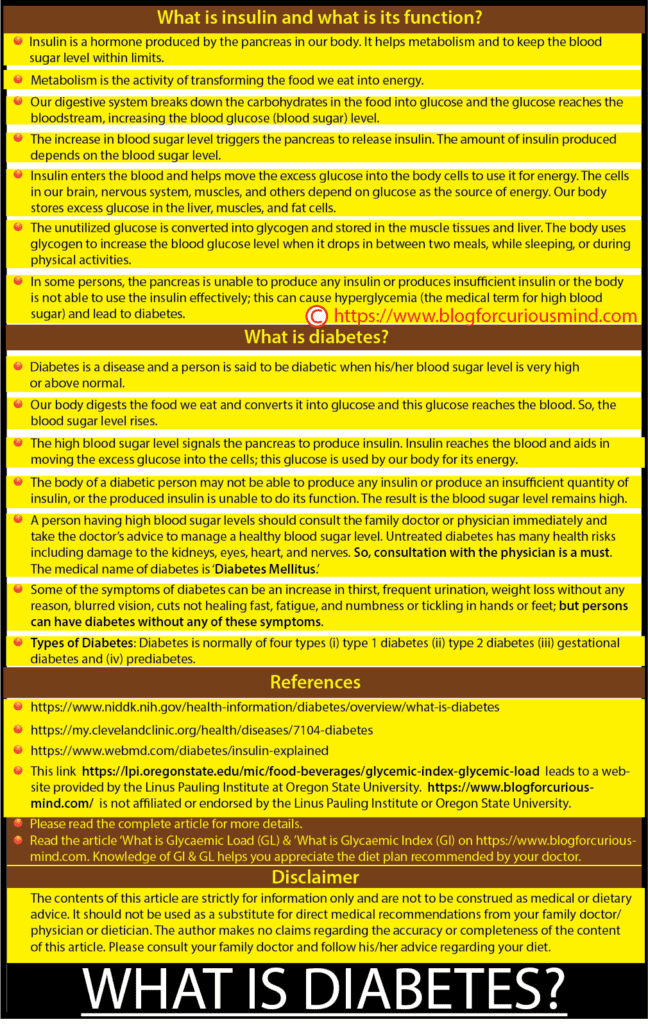Introduction
Diabetes is an illness and a person is said to have diabetes when his/her blood sugar level (also called blood glucose) is very high or above normal. Our body makes glucose by digesting the food we eat and glucose is the main source of energy for our body. Our body cells use glucose for our activities including moving, talking, breathing, working, and thinking.
Insulin is a hormone produced by the pancreas in our body and it helps to move the blood glucose into our body cells; the cells use the glucose for energy. The disease diabetes is a condition where either the body is making nil or insufficient insulin or the body is unable to use the insulin.
The major issue of diabetes is the body is not able to process the glucose or sugar in the blood appropriately.
Diabetes has many health risks including damage to the kidneys, eyes, heart, and nerves. It is a must for everybody to get regular health checkups done as advised by your family doctor and seek the doctor’s advice on the health reports. If you have any symptoms of diabetes, please consult your family doctor immediately and seek his/her advice. Experts say ‘when diabetes is detected timely, it is controllable by medication and lifestyle changes.’
What is diabetes?

Diabetes is a disease and a person is said to be diabetic when his/her blood sugar level is very high. Our body digests the food we eat and converts it into glucose and this glucose reaches the blood. So, the blood sugar level rises. Glucose is the major source of energy for our body.
The high blood sugar level signals the pancreas to produce a hormone called insulin. Insulin reaches the blood and takes the excess glucose into the cells; this glucose is used by our body for its energy.
The body of the person having diabetes may not be able to produce any insulin or produce an insufficient quantity of insulin, or the produced insulin is unable to do its function. The result is the blood sugar level remains high.
A person having a problem with high blood sugar levels should consult the family doctor or physician immediately to take the advice of the doctor to manage a healthy blood sugar level. Untreated diabetes has many health risks including damage to the kidneys, eyes, heart, and nerves. So, consultation with the physician is a must. The medical name of diabetes is ‘Diabetes Mellitus.’
Some of the symptoms of diabetes can be an increase in thirst, frequent urination, weight loss without any reason, blurred vision, cuts not healing fast, fatigue, and numbness or tickling in hands or feet; but persons can have diabetes without any of these symptoms.
Types of Diabetes
Diabetes is normally of four types (i) type 1 diabetes (ii) type 2 diabetes (iii) gestational diabetes and (iv) prediabetes.
Type 1 diabetes: Type 1 diabetes is normally detected in children, but it may occur in the adult stage too. The body of type 1 diabetes patients produces little or no insulin at all. Type 1 diabetes patients have to take insulin for their whole life.
Type 2 diabetes: Type 2 diabetes is the most common type of diabetes and the body of a type 2 diabetes patient is either not able to use the insulin effectively or the pancreas is not able to produce sufficient insulin required for keeping the blood sugar level in the accepted range. The patient is not able to use the insulin effectively because the cells in our liver, fat, and muscles resist the function of insulin and this is termed as insulin resistance.
Persons who are overweight and have a family history of diabetes are at higher risk of getting type 2 diabetes, but it can affect any person at any age. Your physician may advise you on a combination of medication, diet, and lifestyle changes to keep the blood sugar level under control and avoid complications.
Gestational diabetes: Gestational diabetes may occur during pregnancy and given treatment. Normally, gestational diabetes goes away after the birth of the child. Regular consultation with the doctor is a must for women in their pregnancy. Women who had gestational diabetes are at higher risk of getting Type 2 Diabetes later in life.
Prediabetes: Prediabetes is a stage before type 2 diabetes. In this stage the blood sugar level is a bit higher than normal but not as high to diagnose it as type 2 diabetes. Persons with prediabetes should consult their doctors and seek medical advice.
You may watch this and this YouTube videos on diabetes.
For persons having type 2 diabetes, one of the ways to keep their blood sugar level under control is to consume food that does not cause spikes in blood sugar levels. Glycaemic Index (GI) and Glycaemic Load (GL) are the methods of expressing how carbohydrate foods may influence blood sugar levels. Understanding the Glycaemic Index (GI) and Glycaemic Load (GL) and GI and GL of the foods will put you in a better position to discuss and appreciate the diet advised by your family doctor and how the diet may help to keep your blood sugar level under control. Do not change your diet without discussing it with your family doctor.
Please refer to the following website for more information on GI and GL.
This link leads to a website provided by the Linus Pauling Institute at Oregon State University. https://www.blogforcuriousmind.com/ is not affiliated or endorsed by the Linus Pauling Institute or Oregon State University.
Also, please go through the websites mentioned under reference (at the end of this article).
You may watch this, this, and this YouTube videos on GI and GL.
What is insulin and what is its function?
Insulin is a hormone produced by the pancreas in our body and it helps metabolism and to keep the blood sugar level within limits. Metabolism is the activity of transforming the food we eat into energy.
Our body system digests the food eaten by us, the digestive system breaks down the carbohydrates in the food into glucose and the glucose reaches the bloodstream, increasing the blood glucose (blood sugar) level.
When the level of glucose (blood sugar) in the blood increases, the pancreas is triggered to release insulin, a kind of hormone. The amount of insulin produced depends on the level of sugar in the blood, the higher the blood sugar level, the higher the insulin produced.
Insulin enters the blood and helps move the excess glucose from the blood into the cells in the body and the cells use it for energy. The cells in our brain, nervous system, muscles, and others depend on glucose as the source of energy. Our body stores excess glucose in the liver, muscles, and fat cells.
The unutilized glucose is converted into glycogen and stored in the muscle tissues and liver. The body uses glycogen to increase the blood glucose level when it drops in between two meals or while sleeping or during physical activities including exercise.
In some persons, the pancreas is unable to produce any insulin or produces insufficient insulin or the body is not able to use the insulin effectively; this can cause hyperglycemia (the medical term for high blood sugar) and lead to diabetes.
Conclusion


Research and studies suggest that eating of high GI/GL foods may be connected to the risk of negative health conditions including type 2 diabetes. Please consult your family doctor before including any new food to your diet and get the health checkups done regularly.
Today, diabetes in most cases is manageable, thanks to the information and medication available. The doctor may advise you on your diet, medication required, and lifestyle changes including regular physical exercises based on your medical reports. Please consult your family doctor regularly and seek his/her advice to keep you healthy and fit.
Please read the articles on GI and GL, What is Glycaemic Index (GI) and What is Glycaemic Load (GL).
Disclaimer
The contents of this article are strictly for information only and are not to be construed as medical or dietary advice. The content of this article should not be used as a substitute for direct medical recommendations from your family doctor physician or dietician. The author makes no claims regarding the accuracy or completeness of the content of this article. Please consult your family doctor and physician and follow his/her advice regarding your diet and food.
References
https://www.niddk.nih.gov/health-information/diabetes/overview/what-is-diabetes
https://my.clevelandclinic.org/health/diseases/7104-diabetes

